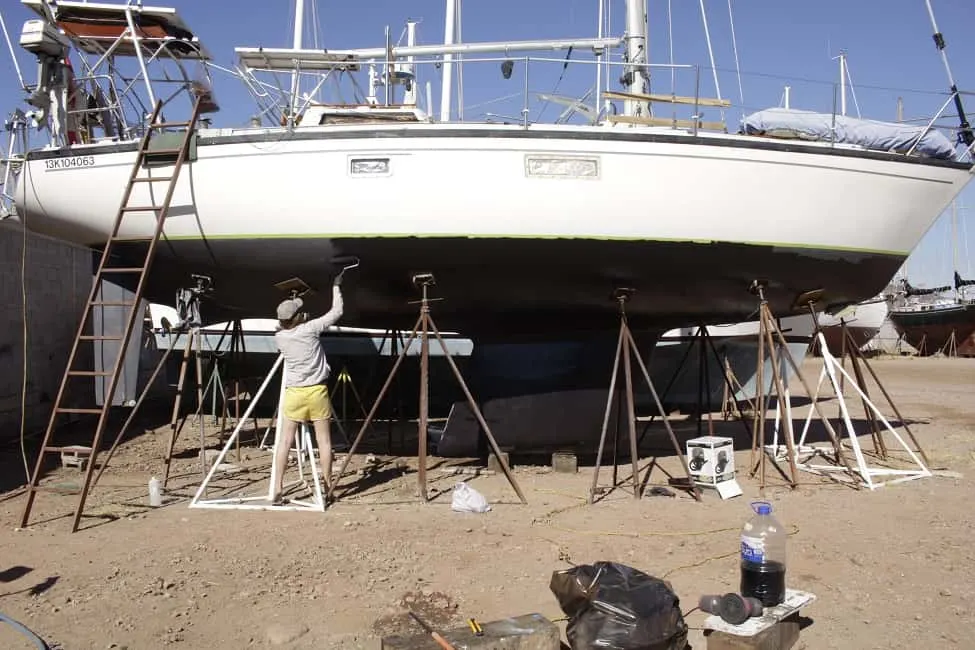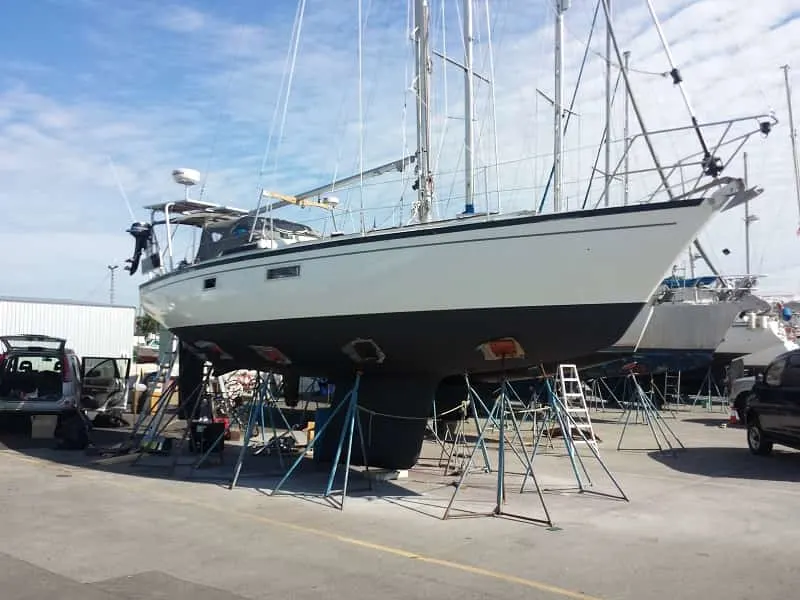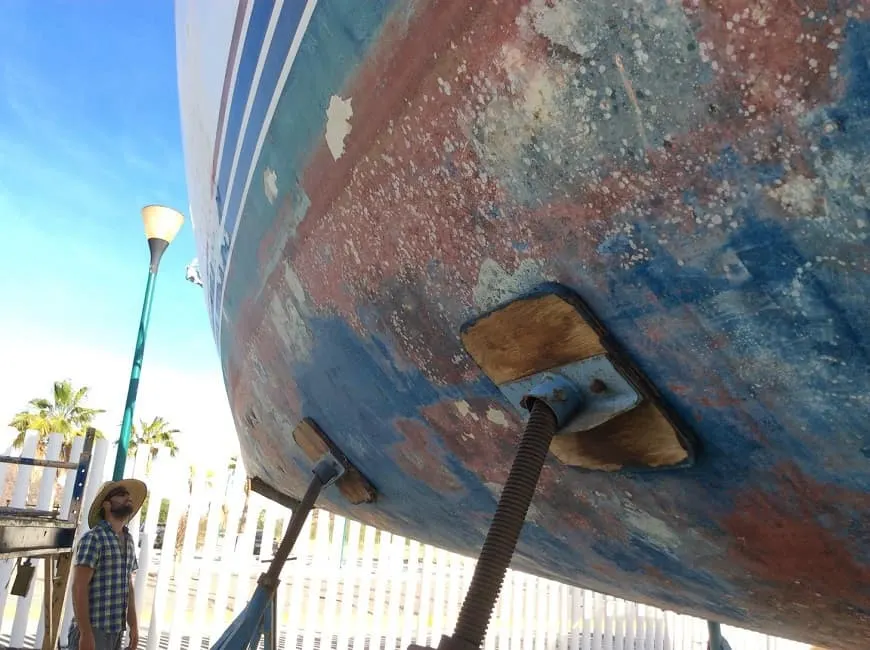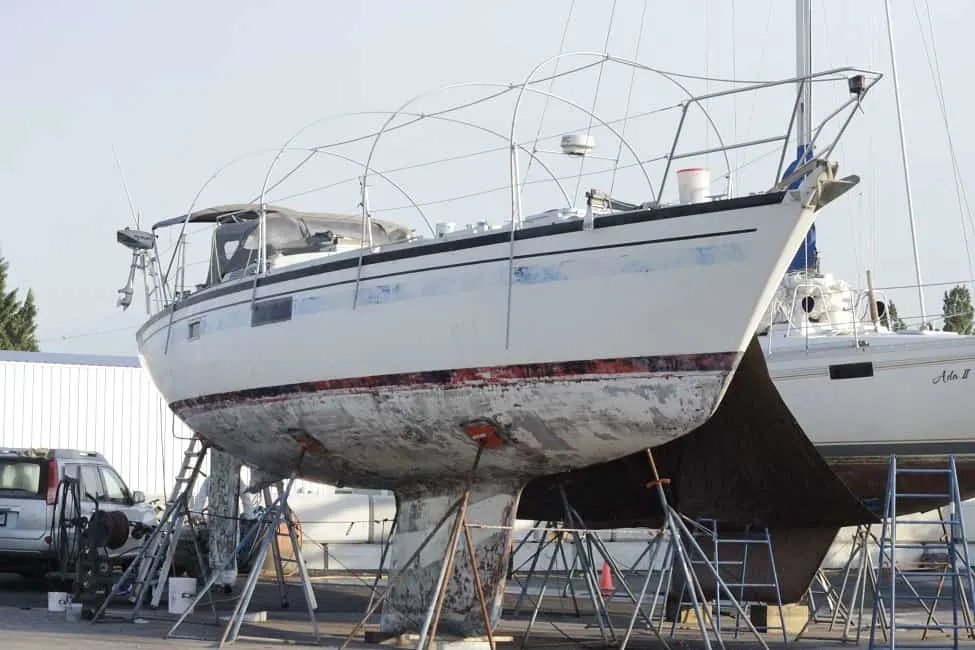You’re perusing the chandlery looking for a gallon of boat bottom paint (a.k.a antifouling paint). You just want to get in, get out, and get on with painting your boat.
But you reach the paint aisle and are awash in choices and confounding terms: hard modified epoxy, premium ablative, water-based, photoactive, thin film … The shop assistant suggests one paint, but your marina neighbor swears by another brand.
You’re feeling defeated. What happened to the good old days of slapping on some tar with a paintbrush and calling it a day?
Welcome to the convoluted (and at times highly controversial) world of marine boat bottom paint!
Fortunately, antifouling paint is not all that complicated. We’ll walk you through the different types of paint, help you choose the right bottom paint for your boat, and list the best boat bottom paint brands in each category.
Note: This post contains affiliate links. If you purchase a product through a link on this site we will earn a small commission. All opinions are our own. Thanks for your support!
What is boat bottom paint?
Antifouling paint is a specialized paint that is applied below the waterline to inhibit the growth of weeds, slime, and animals (e.g., barnacles and tube worms).
All antifouling paints are made from a combination of these four components:
- Biocide (deters living organisms)
- Resin (keeps the paint together)
- Solvent (determines application characteristics and clean up/removal methods)
- Pigment (color and viscosity)
The differences in paints are based on the sources and mixes of these four elements.
For example, the softness or hardness of a paint is determined by the type, combination, and quantity of resin used in the mix. More on the differences between soft and hard paints later!
Do I need bottom paint on my boat?
For boats kept in the water for more than a week at a time, it is necessary to apply boat bottom paint to prevent growth of marine life (fouling).
Why would you bottom paint a boat?
Boat owners apply antifouling paint to the bottom of boats that are left in the water all season because it reduces the growth of marine life (fouling). Fouling not only reduces a boat’s performance but can also permanently damage the hull.
- Fouling can dramatically reduce a boat’s performance. A fouled bottom causes drag, which reduces fuel efficiency, speed, and handling, and can even cause a boat to sit lower in the water.
- Fouling can permanently damage the hull. In extreme cases, where marine growth has been left unchecked for extended periods of time, the “glue” produced by fouling critters can damage fiberglass and wooden boats.
How long does bottom paint last on a boat?
Depending on the marine life in your area, how you use your boat, and how often you clean your hull, you may need to apply antifouling paint anywhere from once a year to once every three years.
When should you bottom paint a boat?
Bottom paint may last one to three years, but you should check to see if it needs new paint, every year. If you see worn-through patches, flaking, blistering, corrosion, or any of the signs below, it’s time to repaint. Clean the bottom of your boat first, so you can see the condition of the paint.
• The paint has worn through. A common practice is to alternate boat bottom paint colors so you can clearly see when this has happened.
• Flaking or blistering paint. When water gets under the paint (often around hardware) it can cause blistering and damage. If you see a fair bit of flaking or blistering, it’s time to repaint.
• If you find yourself using abrasive tools and scrubbing to remove growth while cleaning your hull. Your dive service can also advise you on when it’s time for new paint.
• If you notice performance issues, like reduced boat speed or handling and you have persistent growth on the hull.
• Corrosion (if you have an aluminum boat). Aluminum doesn’t “rust”, though it does produce aluminum oxide which causes paint to flake off, exposing the aluminum underneath.
• Your boat has been stored in the water for three seasons. Despite manufacturer claims to the contrary, most paint jobs don’t last more than three seasons.
A note on timing and temperature
Most boaters apply antifouling paint at the beginning of the season once temperatures have warmed up enough for the paint to dry. It’s important to know that paint will only dry under the right conditions (generally speaking 50-85 degrees F and below 65% humidity). It can be too cold, hot, or humid for the paint to cure, so read the manufacturer’s directions and choose your timing carefully.
Note that hard boat bottom paints lose their antifouling effectiveness when exposed to air so you would not want to apply hard paint in the winter and then store it out of the water for several months.
Types of boat bottom paint
Antifouling paints can generally be classified into three groups: soft paints, hard paints, and hybrid paints. As mentioned previously, the difference between soft and hard paint is the type, combination, and quantity of resin used in the mix.
Ablative bottom paint
Soft bottom paint (a.k.a. self-polishing and ablative bottom paint) is intended to gradually wear away as water flows over the hull. As the paint gradually sloughs off, it exposes fresh biocide, preventing marine organisms from attaching to the hull.
Pros:
- Reduces buildup of old paint (as it’s constantly wearing away) which means less sanding and expense when you go to repaint.
- Soft paints contain less copper but the ablating action means the copper is used more efficiently.
- Does not lose effectiveness when exposed to air.
Cons:
- If the boat is docked for long periods (not moving) the paint will not effectively slough off and fouling will occur.
- Ablative antifouling paints are a poor choice for fast boats because higher speeds quickly wear away the paint.
Generally recommended for:
- Slow boats (e.g. cruising sailboats and non-planing powerboats) that are used frequently as well as boats that are stored out of the water for part of the year. While displacement boats may choose either soft or hard bottom paints, many boat owners opt for soft paints due to the advantages of lack of paint build-up.
Examples:
Hard bottom paint
Hard bottom paint (a.k.a non-sloughing or hard modified epoxy paint) does not erode over time and instead, the biocide leaches into the water. Water will gradually penetrate the paint until the biocide has been completely used up at which point the hard paint is no longer effective.
Pros:
- Great for fast boats (e.g. racing sailboats and powerboats) as their tough exterior does not erode with increased speeds.
- Can be “burnished” (finely sanded and polished) to provide a fast and smooth surface.
- Often contain a higher copper content which means better antifouling performance.
- Can be scrubbed more aggressively than ablative paint when cleaning the bottom of your boat.
Cons:
- Hard paints build up over time with each additional coat unless vigorously sanded back each year. Eventually, the paint may build to a point where it cracks and peels and the hull will need to be stripped back (a very time-consuming process).
- Loses effectiveness when exposed to air. Hard bottom paints are thought to oxidize and lose their antifouling properties when out of the water for more than 72 hours. However, they can be reactivated before relaunching.
Generally recommended for:
- Fast boats (e.g. racing sailboats or planing powerboats) and boats that stay in the water year-round. Ablative paints won’t last long at high speeds and a hard burnished surface will be faster for racers.
Examples:
Hybrid bottom paint
Hybrid bottom paints (aka semi-hard ablative paints) incorporate many of the benefits of both hard and soft bottom paints into a single product. Hybrid paints are self-polishing (like soft paint) and release biocides at a controlled rate (like a hard bottom paint), but they can’t be burnished to a smooth slippery surface for smoothness and speed. They also have less buildup than a hard paint.
Pros
- Ablative action
- Releases biocides
- Less buildup than hard bottom paint
- Holds up to faster speeds
- Can tolerate haulouts and air exposure without loss of protection
Cons
- Can’t be burnished
Generally recommended for
- Highspeed powerboats
- Slower displacement boats
- A fast trailerable boat may be better off with no paint at all as hard paints don’t do well when exposed to air for long periods. If that’s not possible, a hybrid paint may be a better option.
Examples
Things to consider before buying bottom paint
There are a few important things you should consider when choosing a boat bottom paint.
What type of material is my boat’s hull?
Boat hulls can be wood, fiberglass, aluminum, and steel. It’s important to ensure that a paint is appropriate for your boat’s hull material.
For example, aluminum boats must use specialized aluminum-safe paint. The cuprous oxide in regular paints will result in galvanic corrosion and damage an aluminum hull. Aluminum-safe paints use alternate biocides like zinc and cuprous thiocyanate.
For the same reason, you should never paint underwater metal components (like a propeller) with cuprous oxide paints.
Examples of aluminum safe paints:
• Interlux’s Pacifica
• Pettit’s Ultima Eco
What type of paint is on my boat right now?
If you’re repainting a boat you must ensure that any paint you apply is compatible with the existing paint on the hull. West Marine, Pettit, and Interlux all publish compatibility charts for reference.
As a rule of thumb, soft paints can be applied over hard paints but hard paints cannot be applied over ablative paints. To switch from soft paint to hard paint, the soft paint should first be entirely removed.
But what if I don’t know what the old paint on the hull is?
If you don’t know what type of bottom paint is currently on the hull, you can at least determine whether it is hard or soft paint by rubbing the hull with a light-colored, damp rag. If the paint easily rubs off onto the rag, it’s likely ablative.
How often do I use my boat?
If you use your boat frequently, ablative bottom paint is a good choice because fresh biocide will be released as the boat moves through the water.
If your boat will be sitting for long periods, a hard bottom paint may be a better choice.
Where will I be using my boat?
There are many different types of fouling. Marine biologists estimate there are more than 4,000 known fouling species! Generally, these species fall into one of three groups: animals, weeds, and slime.
Factors like water temperature, water quality, nearby population centers, inflows from rivers and streams, the speed of currents, and the amount of sunlight will affect the types and degrees of fouling in your area.
You’ll want to choose a bottom paint that is suitable for the fouling in your area. As fouling can differ from one marina to the next, it’s a good idea to ask the dockmaster or boaters in your marina what fouling they notice and what paint they use.
For example, freshwater areas like the Great Lakes, don’t have to worry about barnacles, but they do suffer from slime. In this case, a thin film paint might be a good option as it offers a super slippery, low friction finish to prevent slime from attaching to the hull.
Examples of thin film paints:
Do I plan on racing my boat?
If you’re looking for high-performance, opt for a hard bottom paint that can be burnished (wet sanded) to a shiny, slippery, and fast finish.
What are the environmental regulations in my area?
The word “biocide” literally means “life-killer”. The biocides used in anti-fouling paint are harmful to aquatic life (and not particularly healthy for humans to work with). It’s widely accepted that accumulated copper from boat bottom paint is detrimental to the marine environment.
In places like California and Washington state, this has led to new environmental regulations regarding the sale and use of boat bottom paints. Many locales also limit copper accumulation by prohibiting in-the-water hull cleaning.
In response to these health risks and environmental concerns, paint manufacturers have begun to offer more environmentally friendly alternatives, including:
- Water-based, low volatile organic compound (VOC) bottom paints
- Copper-free bottom paints containing photoactive materials and organic biocides.
These non-toxic, copper-free, and environmentally responsible alternatives to conventional antifouling paints are effective, kinder to the environment, and healthier for the person using them.
Examples of eco-friendlier bottom paints:
How many coats of bottom paint do I need?
For ablative paint, a single coat is sufficient for a season, whereas two or three coats of paint are recommended for multi-season use.
For hard paint, one or two coats is generally recommended. Additional coats will just add to more sanding down the road.
If in doubt, check the manufacturer’s recommendations.
How many gallons of bottom paint do I need?
The amount of bottom paint you’ll need depends on the size of your boat and how many coats you apply.
You can use this calculation to give you a rough estimate of how many gallons of paint you’ll need per coat.
Calculate the area you’ll need to paint:
[Length of your hull LOA (in feet) x Beam (in feet) x .85]
Then, divide it by the paint coverage listed by the manufacturer.
Area to paint (in square feet) / coverage (in square feet per gallon)
For example, a 35-foot sailboat with a 12-foot beam using a paint with a coverage of 400 square feet per gallon would be:
[35 x 12 x .85] / 400 = .9 gallons per coat
With this information in hand, you can now walk confidently into your local chandlery and make an informed decision on antifouling paint. It’s time to paint!
Fiona McGlynn is an award-winning boating writer who created Waterborne as a place to learn about living aboard and traveling the world by sailboat. She has written for boating magazines including BoatUS, SAIL, Cruising World, and Good Old Boat. She’s also a contributing editor at Good Old Boat and BoatUS Magazine. In 2017, Fiona and her husband completed a 3-year, 13,000-mile voyage from Vancouver to Mexico to Australia on their 35-foot sailboat.










